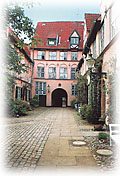 HANSEATIC CITY LUEBECK
HANSEATIC CITY LUEBECK
The Füchtingshof -
A magnificant yard for the poor
The largest and most magnificant of Lübeck's charitable foundations
belongs to the "Johann Füchting Testament" which still exists today as an
independent foundation.
In 1636 Johann Füchting, a tradesman from Lübeck and member from the
town council who came from Westfalen, willed that one third of his
property should be used for the benefit of the poor.
Three years later the executor of his testament bought a house in the
Glockengießerstraße 23-27. For about 35 000 Lübsch Mark the architect
Andreas Jäger built the Füchtingshof as you can visit it today. The
Füchtingshof contained 21 flats for the widows of tradesmen and sailors
who could live there until the end of life. Moreover they got between 10
and 15 Lübsch Mark from an old-age fund.
The director's bureau in the Füchtingshof which resembles very much the
Fuggeri in Augsburg, is one of the most beautiful preserved interior rooms
in Lübeck. It dates back to the 17th century.
Today you can find 28 modern flats for elderly women in the
Füchtingshof. They were built with the financial help of the Possehl-foundation,
the Federal Republic of Germany and the Land Schleswig-Holstein.
The portal of the Füchtingshof is made of sandstone from Gotland. In
1986 it was completely renovated by the sculptor Paul-Heinrich Gnekow.
Of all the epigraphs only the one of the council-member Johann Füchting
got over the big fire in the Marienchurch.
Today you can find the renovated epigraph in the Marienchurch at the side
of the Mengstraße.
|